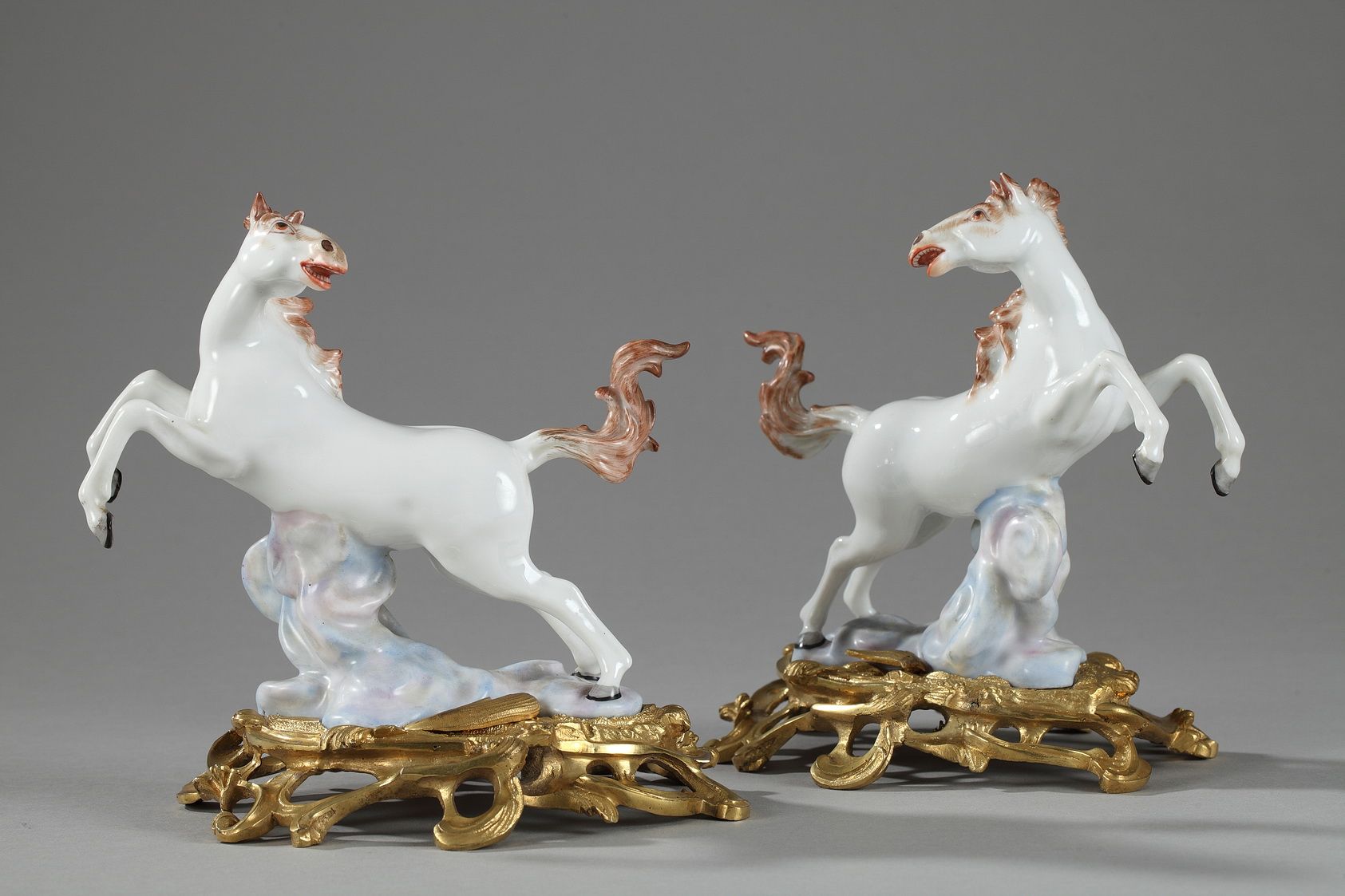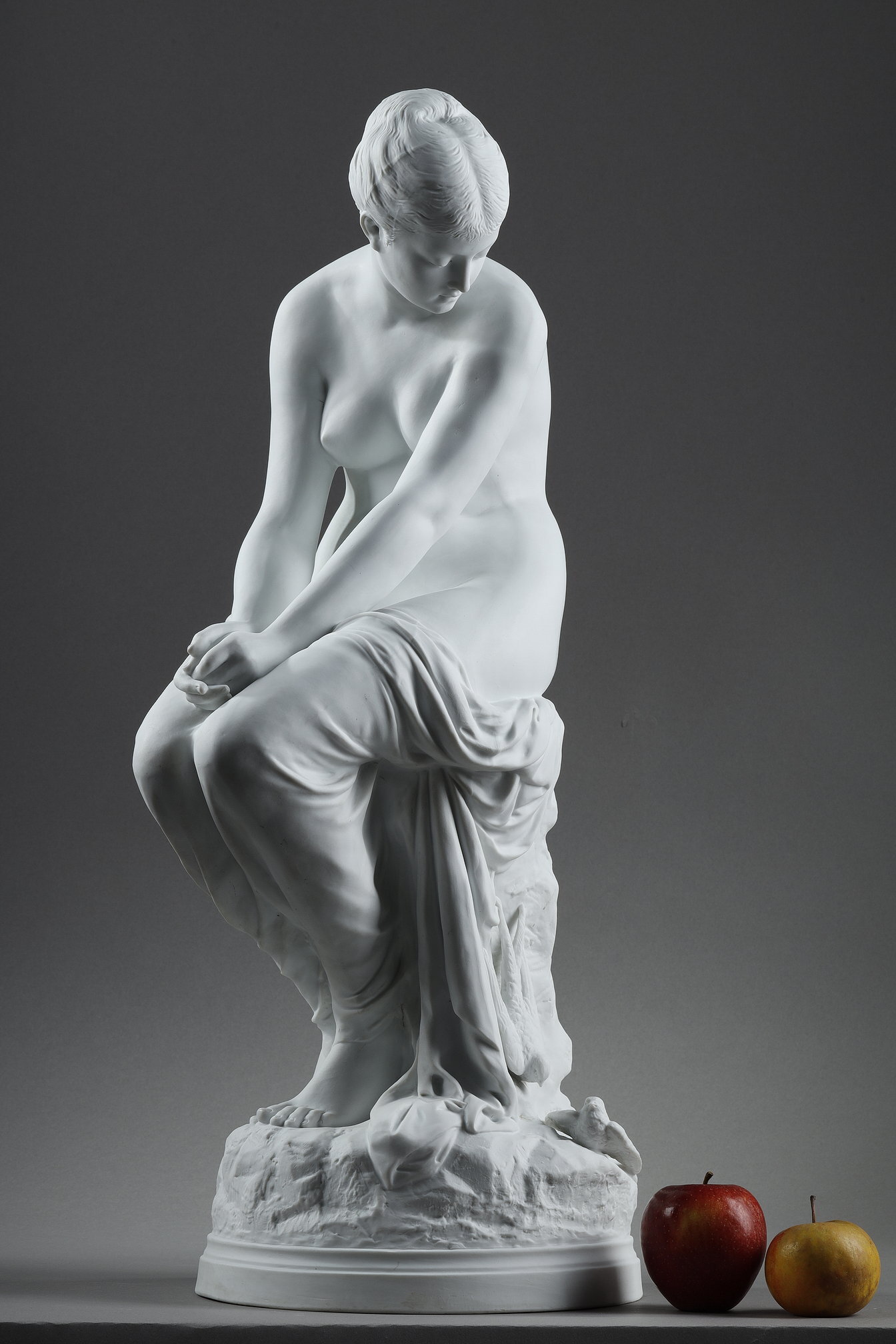The History of Porcelain Bisque
08.12.21
Beware, sea-food lovers! The Bisque that we are going to talk about will make your teeth hurt. Bust, peasant, ball queen or centrepiece, they are immaculately white to decorate interiors. Their production began in the 18th century in a French manufacture that soon distributed them throughout Europe. But what is the Bisque ? What is its history? What is it made of, and how?
THE CREATION OF BISCUIT, AN ECONOMIC CHALLENGE
In the 18th century, aristocrats loved exotic objects: lacquerware, cotton from India and, above all, porcelain. porcelain. The latter, born in China in the 7th-8th centuries, fascinated by its whiteness and translucence. Europeans brought porcelain from the Orient to satisfy their curiosity. In the 17th century, they tried to find the secret of its production, but to no avail. They lacked the essential component for its manufacture: the kaolin.
 Pair of horses from the Samson manufacture imitating Saxon pieces
Pair of horses from the Samson manufacture imitating Saxon pieces
At the very beginning of the 18th century, a deposit was discovered in Germany in Saxony. The manufacturing process was discovered in 1708 and the Meissen manufacture began the first production of Porcelain in Europe. Collectors turned to this new production site to satisfy their tastes, much to the despair of Colbert, Minister of Finance. He had an strong grip on the French economy and promoted French factories in all fields: textiles, furniture, mirrors, etc. But the expenses in porcelain escape him and they represent a loss of capital abroad.
It was then decided to create a factory in France to compete with Saxony Porcelain. In 1745, the king granted a manufacture in the Château de Vincennes the exclusive privilege of making Porcelain "Saxon style with human figure, painted and gilded ". Unfortunately, this was not very successful at first. They mainly produced porcelain flowers to decorate artificial bouquets in vases from the neighbouring country.
Pair of porcelain vases with "Bleu de Valentine" background
Not possessing the secret of the Porcelain The Vincennes factory developed a technique using frit, a glass and crystalpaste that remained white and opaque. At first it imitated German shapes, but the craftsmen noticed that the glaze, transparent or coloured coats on the pieces, was detrimental to the finesse of their work. Indeed, it accumulates in the folds and in the elaborate details of French sculptures, which diminishes their quality. In 1753, Jean-Jacques Bachelier had figurines made that were deliberately left without enamel and without decoration. Thus was born the Bisque.
Grand Biscuit, "Baigneuse aux Hirondelles" by Joseph Peiffer
This was the beginning of a huge success. Louis XV, who bought the factory on the advice of Madame de Pompadour, moved it to Sèvres in 1756. It kept the name of manufacture of Sèvres until today. The king placed large orders for his own decoration, but also for diplomatic gifts. Sèvres porcelain is found in all the European courts. When receiving these delicate works, foreign sovereigns discovered the taste of Bisque. A large number of orders were placed for the Sèvres manufactory, sometimes abandoning the productions of Meissen. France regained the upper hand in the European market.

Amour désarmé par une VestaleBiscuit after Louis-Simon Boizot
The revolution of the french Porcelain took place in 1770 with the discovery of kaolin in the country. Then came the hard paste, a real Porcelain. Louis XV bought the land of Saint Yrieux where the quarry exploiting the precious clay was located. However, it was not until 1774 that its use was established in Sèvres. Production became less time-consuming and less expensive, but it was necessary to succeed in generating fires four times as powerful. At first, it was reserved for biscuits, as the glazes and enamels had not yet been mastered. The small sculptures have a more pronounced whiteness, a soft polish and an almost crystalline sound. This technique also makes it possible to produce large sculptures. This matt white imitates the grain of the Marble statuary and makes the Bisque of Porcelain a real work of art, no longer a mere decoration.
BISCUIT DE SÈVRES OR COPY?
But the Sèvres factory is not alone in producing cookies. Their great success soon led to the production of copies of the porcelain porcelain. Even though it was forbidden to do so, some competing manufactures did not hesitate to recruit craftsmen directly from the royal manufactory, offering them much higher wages. They simply copied existing models, and didn't need to recruit a renowned sculptor to make them.
Bisques are even easier to copy because they do not have a mark. Marks are generally used to determine whether a piece is authentic or not. The 18th century Sèvres manufacture shows the royal monogram, two L's facing each other and a number indicating the date of creation under the cover. However, when the decision is made to create pieces without enamel, a problem arises. What is stopping other factories from buying unglazed pieces with the Sèvres mark and applying an "over-decoration" to them to pass them off as originals? It was decided not to apply the mark to the biscuits.
 Marks of the Sèvres manufacture under a 19th century tea service
Marks of the Sèvres manufacture under a 19th century tea service
Nor can we rely on the word Sèvres affixed to the underside of one of these statuettes. This is no guarantee of its origin, as many factories have set up in the town to benefit from the renown of the royal factory. To distinguish a Sèvres porcelain biscuit , you need to study the quality of the workmanship, the quality of the material and the detailed rendering of the sculpture, which only experts can recognize.
Finally, France was not the only country to produce porcelain bisques. All the European courts tried to set up factories capable of producing these precious ornaments. The Meissen manufacture itself began to produce objects without glaze in order to compete with Sèvres, its great rival.
WHY THE NAMEBISCUIT ?
Originally, to produce this type of piece, the soft, kaolin-free paste was fired twice, hence the term "bis-fired". "bis - cuit". With the discovery of kaolin in France, unglazed figurines only needed to be fired once, but figurines that remained white kept this name.
Today, the definition of Bisque of Porcelain is: figure or group in unglazed Porcelain
CONCLUSION
The cookies are still produced today in many European factories, but Sèvres remains the benchmark for this know-how. Every year, contemporary artists are invited to discover and innovate this technique. Despite its ancient history, biscuit remains a technique firmly rooted in the contemporary world.
Want to know how the porcelain pieces in our collections are made? Go to this article. Want to biscuit to your interior? Discover all our cookies.



